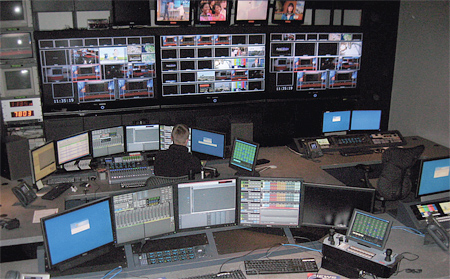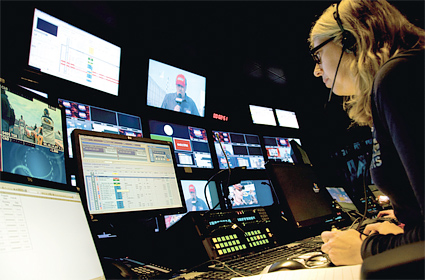Streamlining News Production
DALLAS: News drives "localism," the "Holy Grail" for television-as-we-know-it in the current Bandwidth Battle-to-the-Death. Without news, stations are hardly more than common carriers for commercial-laden content; barely distinguishable from similar cable, satellite, Internet and mobile broadcast-like services.

KPHO's Ignite news control room In a tight economy, budget bucks for feet-on-the-street reporters typically trump funding fingers-on-buttons, so interest in workflow efficiency is strong. Newscast automation—essentially rundown and production device management—promises to lower staff overhead, tame complex eye-candy formats and impose on-air consistency. Success in this niche favors switcher-centric production assist systems that are newsroom computer (NRCS) agnostic, such as Grass Valley's Ignite and Ross Video's OverDrive as well as the embedded play-to-air components of inclusive workflows like Avid's iNEWS and the Dalet News Suite.
A MOUSE CLICK AWAY
An example is KPHO, the Meredith-owned CBS outlet in Phoenix, where an Ignite system, linked to Avid's iNEWS and editing, went live a year ago. "The workflow has gotten much simpler," says Jeffrey Heimburger, broadcast maintenance engineer in-charge. "We had five to eight people running a newscast; now it takes two, plus a prompter operator... it's very streamlined and simplified." He debunks the common misconception that automation precludes breaking news coverage, "It's much easier than rounding-up those eight people on a lunch break... if you code correctly and create 'hot buttons,' e.g., 'Cam-1 with over-shoulder graphic & Mic-1 up,' it can be done in five seconds or less with a mouse click; [you can] cover a breaking event without a timeline or loading a script—just the mouse."
Nor does automation necessarily make all news look the same or lower ratings. "We fly more graphics in the first segment of the 5:00 newscast than Spielberg in his first five movies," observes Heimburger. "Producers have a greater impact on visual and script content... we focus resources on what fills the screen rather than how it gets there! Our ratings have increased [since] news automation; I'm not saying that's the reason—content has something to do with it—but ratings definitely didn't go down because of it."
Scott Matics, Grass Valley's Ignite product manager echoes that. "News is a local station's most valuable asset; it stands to reason the more they're able to create economically, the more reach it will have across varying demographics, i.e., more programming equals more topics of interest to everyone." Using templates, "a less experienced Ignite operator can produce niche content—a web-only sportscast, for example—with the same quality as a top director's [primetime] newscast." Stations are also using Ignite to produce for extra day parts, such as cooking, talk or variety shows, "Doing more than just news [boosts] station bottom lines and local market presence," Matics said.
AN 'EFFICIENCY TOOL'
Ross Video's OverDrive is "at its heart, an efficiency tool," says Allan Pepper, marketing product manager, technical. Producers can "more clearly communicate details and changes to technical staff... OverDrive's tight coupling between news and control rooms [makes] production processes more efficient, creating consistently clean, fast-paced shows in less time." Because news changes constantly, "better communication gets late-breaking updates on-air faster, with less effort and fewer errors; it shifts production costs from the control room to the field."
For the Sinclair Broadcast Group, which does news at 42 of its stations in 36 individual markets, "Automation of news production was a given," says Mark Nadeau, the group's director of TV production. "It was a matter of waiting for it to mature enough to trust... is it fully matured? We don't think so, but it's advanced immensely and the timing's right as we convert news to HD." Known for efficiency, Sinclair's goal wasn't eliminating positions, "but making people more efficient and [able to create] a higher quality, more consistent product." After examining numerous offerings, "OverDrive rose to the top ...as a director/TD going on 30 years, I was confident it [would be] the most user friendly, flexible and powerful; I have no regrets."

In the control room at the Charlotte headquarters of SPEE D, Associate Director Erin Lambkin monitors the Dalet OnAir application, which is used for playout of all rundown-driven programs. From the start, Ross trainers emphasized teamwork between producers and directors. "Directors no longer mark rundowns they had little involvement with 15 minutes before air; we're seeing a team working together to produce a better product," says Nadeau. A consistent newscast look is another plus. "Weaker director/TDs can run shows developed by a more skilled peer or create events too difficult to run manually... they tend to push the envelope now." With OverDrive, Sinclair is free to choose preferred peripherals, among them Avid iNEWS and video servers, Chyron graphics, Telemetrics robotics and Wheatstone audio. Three new HD sets installed last year feature large on-camera monitor walls. "Controlling those walls with [all] their configurations and AUX inputs would be very difficult without OverDrive to do the heavy lifting," Nadeau said.
"It's about producing a cleaner more consistent show with higher production value," he added. "OverDrive gives us an edge in the marketplace with network-level sets, etc.... that means more viewers and higher ratings." Nadeau expects to use OverDrive to expand minimally staffed content production, such as news on sub-channels or overnight on primary ones.
SIMPLIFIED
For those who prefer a single-sourced newsroom workflow, Avid translates journalistic effort to on-air minutes via iNEWS Command, which controls a range of Avid and third party video devices and integrates with iNEWS or any MOS-compliant NRCS. "It's more focused than GV or Ross," says Jim Frantzreb, senior market segment manager, media enterprises. "[They] seek to automate the entire production operation... but also involve significantly greater complexity and expense. iNEWS Command fits a unique niche; [it 's] simpler and more targeted than those systems, but a more professional and reliable solution than low-end automation products."
WISC, the Madison, Wis.-based CBS affiliate, has used iNEWS Command for three years. Production Director Al Barcheski observes, "it's easier for one or two people to interact with [multiple] Chyron and AirSpeed channels in live situations... just listen for the cue and hit Play Next." With automation, they're more open to "graphic ideas that [capture] viewers and ratings... 'mini-opens' for example, with rapid fire video clips and animations to introduce individual stories, series and weathercasts."
The Dalet News Suite offers a similar "big tent" workflow. Its OnAir module "manages playout and is designed for fast-paced environments where immediacy is key, such as news, sports and studio production," said Raoul Cospen, director of marketing, Dalet digital media systems. OnAir's playlist bi-directionally synchronizes with newsroom rundowns and playlists in realtime, "allowing for last second updates, whether breaking news or adding commercial breaks." Late arriving content "can get to air extremely fast because OnAir enables play-out even as files are recorded, transferred, or while being rendered using Dalet editing tools [or selected] NLEs, including Final Cut Pro." Dalet's OnAir application can also trigger delivery to different platforms [such as] the Web, new media or external video walls [and] display different bugs, logos or ads during playout for "hyper-local" news.
News is crucial to station survival in the struggle for relevance and audience mindshare. Many identify their local outlets more by newscast "brand" than network or call letters. Done right, automating the go-to-air workflow can satisfy the budget hawks and grow ratings-based revenue with a better news product.
Get the TV Tech Newsletter
The professional video industry's #1 source for news, trends and product and tech information. Sign up below.
